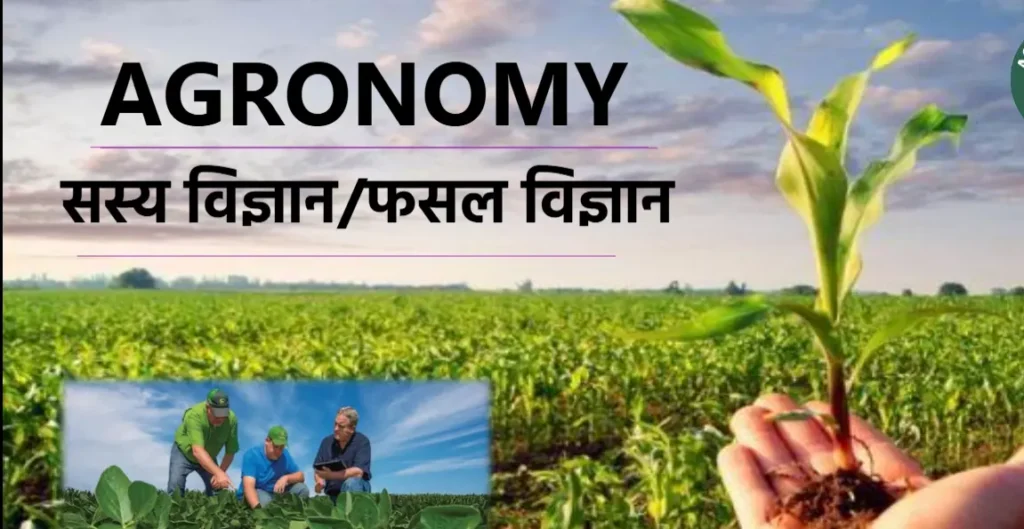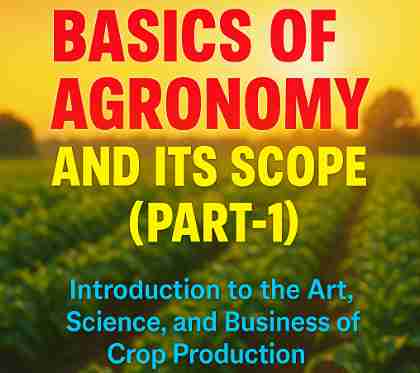
Fundamentals of Agronomy is a subject that explains the basic principles of farming, like tillage, sowing, irrigation, and nutrition, in detail. These notes are useful for B.Sc. agriculture students as well as those preparing for agriculture exams.
On this page, you will get visual notes, easy explanations, and MCQs part-wise according to the 6th Dean Committee syllabus—in a systematic and beginner-friendly format.
🔍 What will you find on this Fundamentals of Agronomy PPT page?
- ✅ Topic-wise division according to the Latest ICAR Syllabus
- ✅ Attractive PPT-style visual notes for every topic
- ✅ Easy-to-read summary after every topic
- ✅ MCQs with answers for practice
- ✅ Part-wise navigation buttons for easy access
BSc Agriculture First Semester Subjects (6th dean committee)
Semester I Courses | Credits |
Deeksharambh (Induction cum Foundation Course) | 1 Week (NG) |
Skill Enhancement Course-I | 2(0+2) |
Skill Enhancement Course-II | 2(0+2) |
Communication Skills | 2(1+1) |
Farming-based Livelihood Systems | 3(2+1) |
Rural Sociology & Educational Psychology | 2(2+0) |
Fundamentals of Agronomy | 3(2+1) |
Fundamentals of Soil Science | 3(2+1) |
Fundamentals of Horticulture | 3(2+1) |
NSS-I / NCC-I | 1(0+1) |
Total Credits (Semester I) | 21 (11+10) |
B.Sc. Agriculture First Semester Syllabus (6th dean committee)
First Semester— Fundamentals of Agronomy syllabus (New Syllabus)
Theory
Agronomy and its scope: Definition, meaning and scope of Agronomy; art, science and
business of crop production, relation of Agronomy with other disciplines of Agricultural Science,
and
fields, crops, and classification; importance, ecology and ecosystem. Seeds and sowing: Definitions
of crops, variety and seed. Factors affecting crop stands establishment: good quality seed, proper
tillage, time of sowing seed rate, depth and method of sowing: broadcasting, drilling, dibbling,
transplanting etc. Tillage and tilth: Definition, objectives, types, advantages and disadvantages of
tillage including conservation tillage. Crop density and geometry: plant geometry and planting
geometry, its effect on growth, yield.
Crop nutrition: Definition of essential nutrients, criteria of essentiality, functional elements,
classification of essential nutrients, role of macro and micro nutrients. Nutrient absorption, active
and passive absorption of nutrients, forms of plant nutrients absorbed by plants, Combined /un
combined forms. Manures and fertilizers, nutrient use efficiency: Sources of nutrients: Inorganic
(fertilizers), organic (manures) and bio-fertilizers; their classification and characteristics, method
of preparation and role of organic manures in crop production. Integrated Nutrient Management
(INM): Meaning, different approaches and advantages of INM. Green manure- role in crop
production: Definition, objectives types of green manuring, desirable characteristics, advantages
and limitations of green manuring.
Water management: Water resources of the world, India and the state; Soil Moisture constants:
gravitational water, capillary water, hygroscopic water, Soil moisture constants.
Weeds: Definition, Importance and basics of classification of weeds and their control. Agro
climatic zones of India and the state, cropping systems: Factors affecting cropping systems, major
cropping patterns and systems in the country. Sustainable crop production: Definition, importance
and practices, natural resources and conservation pollution and pollutants, Allelopathy: Meaning
and importance in crop production, Growth and development of crops: Definition, Meaning and
factors affecting growth and development.
Practical
A visit to the Instructional Crop farm and study on field crops, Identification of crops, seeds,
fertilizers, pesticides, Crops and cropping systems in different Agro-climatic zones of the state,
Study of some preparatory tillage implements, Study of inter tillage implements, Practice of
ploughing / puddling, Study and practice of inter cultivation in field crops, Numerical exercises
on calculation of seed, plant population and fertiliser requirement, Study of yield contributing
characteristics and yield estimation of crops, Identification of weeds in different crops,
Fundamentals of Agronomy syllabus Breakdown Into 15 Parts
🟩 PART 3: Seeds and Sowing
🟩 PART 4: Tillage and Tilth
🟩 PART 5: Crop Density and Geometry
🟩 PART 6: Crop Nutrition – Basics
🟩 PART 7: Nutrient Absorption Mechanisms
🟩 PART 8: Manures, Fertilisers and INM
🟩 PART 9: Green Manuring
🟩 PART 10: Water Management
🟩 PART 11: Weed Science (Basics)
🟩 PART 12: Agro-Climatic Zones
🟩 PART 13: Sustainable Crop Production
🟩 PART 14: Allelopathy in Agronomy
🟩 PART 15: Growth and Development of Crops
Fundamentals of Agronomy Part- 1 (Agronomy Basics and scopes) PPT

Topics Cover
Definition, Meaning and Scope of Agronomy
Agronomy as Art, Science, and Business of Crop Production
Relationship of Agronomy with Other Agricultural Sciences
Ecology and Ecosystem—Basic Concepts in the Context of Agronomy
Fundamentals of Agronomy Part- 2 (Field Crops and Classification) PPT

Topics Cover
What are field crops?
Classification of Field Crops (based on season, use, lifecycle)
Importance of Different Crops in Indian Agriculture
Click to Join Our Free WhatsApp Group for Agriculture Updates!
Get daily updates, free study material, and the latest schemes, and connect with other agriculture students and farmers.
